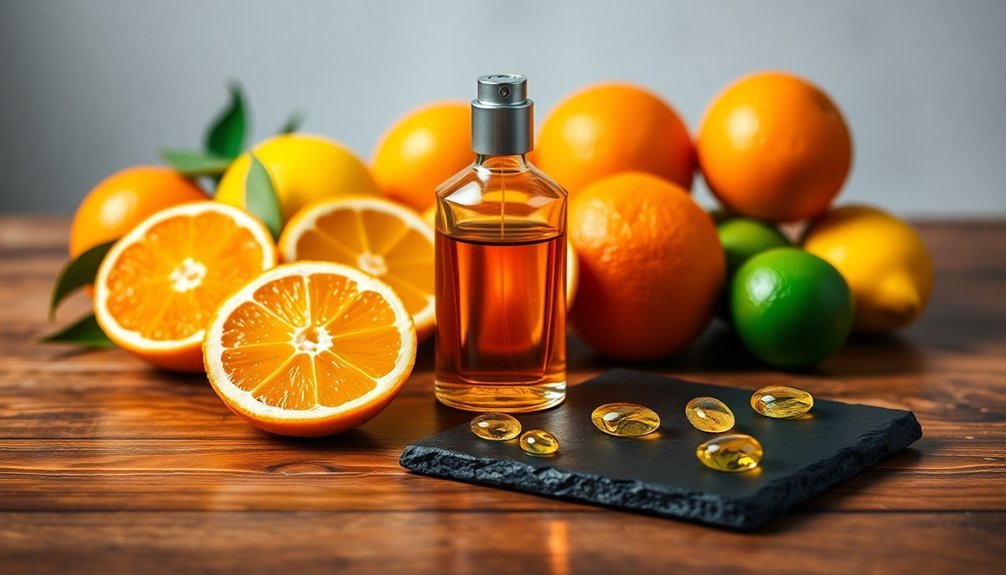Several citrus oils pair beautifully with amber perfume to create a balanced and sophisticated scent. You'll find that bergamot, sweet orange, and blood orange work exceptionally well, offering fresh, bright notes that complement amber's warm, resinous character. Start with a 3:1 ratio of citrus to amber for the best results, and don't forget to test small batches first. Understanding the art of combining these oils will reveal endless fragrance possibilities.
Understanding Amber's Aromatic Profile

While amber isn't a single ingredient but rather a blend of components, its distinctive aromatic profile has become a cornerstone of modern perfumery.
You'll discover a complex layering of warm, sweet notes anchored by rich resins like labdanum, which contributes a caramelized, root beer-like spiciness to the blend.
At its heart, amber perfume delivers a luxurious combination of vanilla sweetness, benzoin's smoky leather undertones, and subtle spices like cinnamon or nutmeg. This sophisticated blend often evokes the essence of sultry evenings through its rich allure.
The composition typically unfolds in stages, starting with an inviting warmth, followed by honeyed heart notes, and ending with deep, lasting base notes.
As a fixative, amber helps other fragrance elements persist longer on your skin, while its versatile nature allows it to range from gentle and soothing to vibrant and seductive.
Top Citrus Oils That Complement Amber
When you're exploring citrus and amber combinations, you'll find orange and lemon oils create particularly striking pairings with amber's warmth.
The fresh, uplifting qualities of these citrus oils perfectly balance amber's rich, resinous character. This combination provides a luxurious experience that won't dry out your skin like alcohol-based perfumes.
Blood orange stands out among citrus choices, offering a deeper, slightly tart complexity that enhances amber's sophisticated profile while maintaining the sunny, vibrant feel characteristic of citrus notes.
Orange and Lemon Pairings
Among the most harmonious fragrance combinations, citrus oils like orange and lemon create a perfect symphony with amber notes.
You'll find that orange adds a sun-drenched, invigorating character while lemon brings a bright, energizing dimension. Both citrus oils balance amber's deep, sweet, and woody essence beautifully. Start with light scent combinations and gradually build up to more complex layering as you become comfortable with the pairings.
You can layer these scents by applying amber perfume first, then adding your chosen citrus oil on top.
If you're using perfume oils, you'll enjoy longer-lasting fragrance and additional skin benefits, especially when they're formulated with organic ingredients like jojoba or coconut oil.
For the best results, apply to your pulse points – wrists, neck, and chest.
Whether you're heading out for day or evening occasions, these pairings offer versatility while creating an uplifting yet sophisticated fragrance experience.
Blood Orange With Amber
Blood orange stands as a sophisticated choice among citrus oils that pair exceptionally well with amber fragrances.
You'll find that its complex blend of apple, blood orange, grapefruit, and lemon notes creates a fresh, zesty aroma that perfectly balances with amber's warmth.
The fragrance unfolds through elegant middle notes of jasmine, plum, and water lily, which bridge the gap between the initial citrus burst and the rich base notes.
When you experience the dry-down, you'll notice how the amber seamlessly melds with sandalwood and berry undertones, creating a long-lasting, sophisticated finish.
What makes this combination truly special is its versatility and universal appeal.
The layered complexity guarantees the blood orange remains interesting while enhancing, rather than overwhelming, the amber's natural warmth.
Creating Perfect Citrus-Amber Ratios

When you're starting to blend citrus oils with amber, you'll want to test different proportions beginning with a 3:1 ratio of citrus to amber.
For a simple two-oil blend, try combining 15 drops of lemon or grapefruit with 5 drops of amber oil to create a balanced foundation.
The key to success lies in maintaining the proper balance between your base notes (amber) and top notes (citrus), ensuring the fresh opening notes don't overpower the warm, lasting amber foundation.
Testing Different Oil Proportions
Creating the perfect citrus-amber blend requires careful experimentation with different oil proportions.
You'll want to start with small batches, using a 20:80 ratio of citrus to amber as your baseline. This allows you to adjust the balance without wasting precious ingredients while finding your ideal scent profile.
- Begin with 2-3 drops of citrus oil mixed with 8-10 drops of amber
- Test the blend on a paper strip first, then on your skin
- Wait 15 minutes to evaluate how the scent develops
- Document each variation to track your preferred combinations
- Adjust the ratios in small increments of 5-10%
Remember to use concentrated fragrance oils for best results, and always perform a patch test before applying new blends.
The final fragrance should showcase both the bright citrus notes and the warm, lingering amber base.
Simple Two-Oil Blending Guide
The art of two-oil blending starts with mastering simple citrus-amber combinations before exploring more complex formulations. You'll want to start with a basic ratio of 3:2 (citrus to amber) and adjust based on your preference for brightness versus depth.
| Citrus Oil | Ratio | Best For |
|---|---|---|
| Bergamot | 3:2 | Classic elegance |
| Sweet Orange | 2:2 | Warm comfort |
| Grapefruit | 4:2 | Fresh energy |
When creating your blend, add the amber first, followed by your chosen citrus oil. Let the mixture rest for 48 hours to allow the scents to meld properly. Remember to store your creation in an amber bottle away from direct light and heat. You can adjust these ratios slightly to achieve your desired fragrance profile while maintaining the integrity of both oils.
Ideal Base-Top Note Balance
A perfect citrus-amber balance depends on understanding the unique interplay between these contrasting notes. Start with a 2:1 or 3:1 ratio of citrus to amber, then adjust based on your desired outcome.
Remember that citrus oils provide bright, invigorating top notes while amber adds warm, comforting depth as a base note.
- Higher citrus ratios create an energetic, uplifting fragrance perfect for daytime wear
- More amber delivers a richer, more sensual scent ideal for evening use
- Bergamot and mandarin offer sweeter citrus profiles that blend seamlessly with amber
- Lime adds crispness, while orange and grapefruit provide deeper citrus dimensions
- Adding fixatives like vanilla or musk helps stabilize the blend and extend longevity
Fine-tune these ratios through small adjustments until you achieve your perfect balance of fresh and warm notes.
The Science Behind Citrus-Amber Blending

Successfully blending citrus and amber notes requires understanding their molecular interactions and sensory characteristics.
When you combine the bright, zesty molecules of citrus oils with amber's rich, resinous compounds, you'll create a harmonious fusion that enhances both elements. The molecular structure of bergamot, lemon, and lime oils naturally complements amber's warm profile.
You'll find that citrus oils can effectively offset amber's density while maintaining its sophisticated character. The key lies in proper proportions – start with 10-20% citrus oils to avoid overwhelming the amber base.
These ingredients share common ground in the fragrance wheel, which explains their natural compatibility. The citrus components typically occupy the top notes, while amber anchors the base, creating a seamless shift from fresh to rich throughout the fragrance's development.
Essential Blending Techniques and Tips
When you're ready to blend citrus oils with amber, start by testing small quantities on perfume strips to understand how different ratios affect the final scent.
You'll want to use the fragrance wheel as your guide, focusing on complementary and adjacent scent families while keeping the 30-50-20 rule in mind for top, middle, and base notes.
Begin with simple two-oil combinations before working your way up to more complex blends that can include multiple citrus oils balanced against amber's rich base notes.
Testing Your Oil Ratios
The right balance of essential oils can make or break your amber and citrus perfume blend. To achieve the perfect harmony, you'll want to follow the 30/50/20 rule: 30% top notes (citrus), 50% middle notes, and 20% base notes (amber).
Start with a small test batch of just 5 drops to perfect your blend before scaling up.
- Begin with 2 drops of your chosen citrus oil, like bergamot or sweet orange
- Add 2 drops of a complementary middle note, such as lavender or ylang-ylang
- Include 1 drop of amber or another base note like vanilla
Test the blend on a paper strip and let it develop over several hours. Document your ratios and adjustments for future reference.
Remember to perform a patch test before applying your final blend to guarantee skin safety.
Master The Fragrance Wheel
Now that you've tested your oil ratios, mastering the fragrance wheel will take your blending skills to the next level. You'll discover three essential techniques to create perfect amber-citrus combinations: the neighbor, opposite, and triangle methods.
| Technique | Method | Example Blend |
|---|---|---|
| Neighbor | Pair adjacent families | Amber + Sweet Orange |
| Opposite | Blend contrasting families | Amber + Lime |
| Triangle | Combine three subfamilies | Amber + Bergamot + Lemon |
| Balance | Match intensities | Light amber + Grapefruit |
| Layer | Build complexity | Amber base + Citrus top notes |
Each technique offers unique possibilities for your amber-citrus perfume. The neighbor method creates harmony, while opposites add intrigue. The triangle approach lets you build complex, multi-layered scents. Choose your technique based on whether you want subtle harmony or bold contrasts in your final blend.
Start Simple, Build Complex
Starting your amber-citrus perfume journey with simple combinations lets you master essential techniques before tackling complex blends. Use the 30/50/20 ratio rule when experimenting with your first amber-citrus creation, and always test your blends on perfume strips to preserve your oils and maintain accuracy.
- Start with a 1:1:1 ratio using one citrus oil (like bergamot), one amber base, and one middle note.
- Test each combination on separate perfume strips, taking breaks between sniffs to avoid nose fatigue.
- Document successful ratios and combinations in your blending journal.
- Use high-quality amber and citrus oils from trusted suppliers to guarantee the best results.
- Gradually increase complexity by adding one new oil at a time, maintaining proper dilution rates.
Seasonal Variations in Citrus-Amber Combinations
Depending on the season, citrus-amber combinations can create dramatically different fragrance experiences throughout the year. You'll find that spring and summer call for bright, invigorating citrus notes like grapefruit and lime, while autumn demands warmer citrus elements like mandarin and blood orange.
| Season | Citrus Notes | Amber/Base Notes |
|---|---|---|
| Spring | Lime, Bergamot | Light Amber, Cedar |
| Summer | Grapefruit, Lemon | Marine Notes, Light Musk |
| Fall | Mandarin, Blood Orange | Rich Amber, Vanilla |
| Winter | Sweet Orange, Tangerine | Deep Amber, Oud |
| Year-round | Bergamot | Medium Amber, Sandalwood |
For warmer months, you'll want to layer citrus over light amber with marine accents, while autumn combinations benefit from spicier elements like clove and cinnamon alongside deeper amber bases. The key is adjusting the intensity and warmth of both citrus and amber components to match the season's character.
Common Mistakes to Avoid When Blending

While mastering seasonal combinations is important, understanding common application mistakes can make or break your citrus-amber fragrance experience.
When applying your citrus-amber blend, you'll want to avoid these common pitfalls that can diminish its unique character and longevity.
- Don't rub your wrists together after application, as this breaks down the delicate citrus top notes.
- Skip spraying directly on your clothes, as citrus-amber fragrances need skin contact to develop properly.
- Avoid applying on dry skin – always moisturize first to lock in the scent.
- Never over-spray, as citrus notes can become overwhelming when used excessively.
- Let the fragrance air dry naturally to preserve its complex layers.
Remember to spray 2-4 times on well-moisturized pulse points, allowing your body's natural chemistry to enhance the citrus-amber combination.
Advanced Layering Methods
To achieve a sophisticated citrus-amber blend, layering requires more than simple application of one scent over another.
You'll want to start by applying amber perfume oil as your foundation, focusing on your pulse points. Then, strategically add your chosen citrus oils in lighter amounts to complement rather than overpower the base.
For the most effective layering, try applying your amber and citrus oils to different areas of your skin, then gently blend them together. Your wrists, neck, and behind your ears are ideal spots for this technique.
Remember to adjust your ratios based on the time of day and season – lighter citrus notes work best for daytime and summer wear, while deeper citrus oils pair well with amber for evening occasions and winter months.
Storage and Shelf Life Guidelines

Proper storage greatly impacts the longevity and quality of your citrus and amber fragrance oils. To maximize shelf life and maintain potency, you'll need to store your oils in a cool, dry environment away from direct sunlight and heat sources.
Choose dark glass bottles with secure, non-reactive caps to protect against light degradation and contamination.
- Store oils in a well-ventilated area away from flammable materials
- Keep bottles tightly sealed and inspect them regularly for damage
- Track purchase dates and expect a 2-5 year shelf life when stored correctly
- Monitor oils for changes in color, consistency, or scent
- Handle oils with clean hands and wear protective gear when working with larger quantities
Remember to reference your IFRA guidelines and SDS documents for specific safety recommendations while handling your fragrance collection.
Therapeutic Benefits of Citrus-Amber Blends
Beyond their enchanting fragrances, citrus-amber blends offer remarkable therapeutic benefits that can enhance both physical and emotional well-being.
You'll find these combinations particularly effective for boosting your mood and reducing stress, as bergamot and orange oils work with amber to promote relaxation and emotional balance.
The blend's immune-supporting properties are impressive, combining citrus oils' pathogen-fighting abilities with amber's anti-inflammatory effects.
You'll also notice improved mental clarity and energy levels, as citrus oils enhance alertness while amber provides a calming foundation.
For skincare, you'll benefit from the blend's dual action: citrus oils help remove toxins and address specific skin concerns, while amber oil protects against free radicals and UV damage.
Together, they'll improve circulation and promote overall skin health.
Professional Blending Secrets

Professional perfumers rely on three fundamental secrets when blending citrus oils with amber: precise measurements, systematic layering, and patient evaluation.
You'll want to start with just two or three main ingredients to form your fragrance's foundation, using standardized droppers for accuracy and consistency.
When creating your citrus-amber blend, follow these essential steps:
- Select your primary citrus oils (lemon, bergamot, or orange) and amber base
- Start with equal proportions of each ingredient
- Add one drop at a time, evaluating after each addition
- Document every measurement and adjustment you make
- Let your blend mature for at least a week before final assessment
Remember to maintain detailed records of your successful combinations, as this will help you replicate and refine your signature scents in the future.
Frequently Asked Questions
Can Citrus-Amber Perfumes Stain Clothing or Jewelry?
You'll find that citrus-amber perfumes rarely stain your clothing or jewelry. While oil-based versions can leave marks if overapplied, most modern formulations are designed to be colorless and clothing-safe when used properly.
Is It Safe to Wear Citrus-Amber Fragrances in Direct Sunlight?
You shouldn't wear citrus-amber fragrances in direct sunlight, as they can cause skin irritation and photosensitivity. Instead, apply them to covered areas or choose sun-safe alternatives to avoid potential reactions.
How Do Citrus-Amber Blends Interact With Other Perfumes I'm Wearing?
Your citrus-amber blends will complement most fragrances, especially florals and orientals. They'll add brightness to heavy scents and depth to lighter ones. Just be careful not to mix too many strong scents.
Can These Blends Trigger Allergies in People Sensitive to Citrus Fruits?
Yes, if you're sensitive to citrus fruits, these blends can trigger allergic reactions like skin redness and itching. It's crucial to do a patch test first and discontinue use if you experience any irritation.
Do Citrus-Amber Fragrances Attract Insects During Outdoor Activities?
You'll find that citrus-amber fragrances typically don't strongly attract insects. While some perfumes draw bugs, the citrus component can actually help repel them, making these blends relatively safe for outdoor wear.
In Summary
You've now got the knowledge to create stunning citrus-amber combinations in your perfumes. Whether you're using bergamot, sweet orange, or tangerine, remember to start with small amounts and adjust gradually. Keep your blends stored properly, and you'll enjoy these sophisticated fragrances for months to come. Trust your nose, experiment with different ratios, and don't be afraid to create your own signature citrus-amber blend.
References
- https://www.sweetessentialsstore.com/products/citrus-amber-perfume-oil
- https://www.candlescience.com/learning/fragrance-oil-blending-101/
- https://www.tiktok.com/discover/how-to-layer-frenshe-citrus-amber
- https://essentialsbycatalina.com/product/lemon-amber-fragrance-oil/
- https://www.pinterest.com/ideas/amber-essential-oil-blends/952045813025/
- https://creedboutique.com/blogs/creed-journal/your-guide-to-amber-perfumes
- https://fragrancelord.com/blogs/news/what-does-amber-perfume-smell-like
- https://us.clivechristian.com/blogs/olfactive-family/the-essence-of-amber
- https://experimentalperfumeclub.com/amber-in-perfume/
- https://www.bonparfumeur.com/blogs/journal/amber-in-perfumery





Leave a Reply